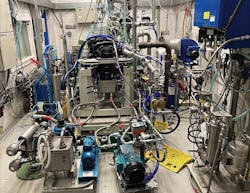CGI Matches Aluminum for Weight, with Performance Advantages
Compacted graphite iron specialist SinterCast AB reported an important development for lightweight internal combustion engines (ICE), a market segment that has become dominated by aluminum due to automakers’ determination to reduce vehicle weight and minimize their own carbon footprint liabilities. Sintercast – which has developed and licensed the most widely adopted CGI production method – working together with its longtime customer Tupy SA and environmental engineering consultant Ricardo plc, revealed a new concept for inline gas, ethanol, or synthetic fuel engines that also addresses the lifecycle CO2 concerns of manufacturers while fulfilling automakers’ lightweight expectations.
Tupy operates multiple iron foundries supplying engine blocks to automotive, commercial vehicle, and other OEMs. It produces 100,000 metric tons/year of CGI cylinder blocks and heads. In April, at the 2022 Vienna Motor Symposium, Tupy unveiled a redesigned three-cylinder engine, and published a study on the results.
While CGI has gained a significant presence in the market for heavy-duty cylinder blocks and heads, and for diesel engine blocks, there is no example of CGI in use for series production of engine blocks for passenger cars. Starting from a current-model 1.2-liter, three-cylinder aluminum block, Tupy redesigned the engine’s running surfaces and structural segments to be cast in CGI, with the block’s outer enclosures produced in low-density, high-durability plastic (PA66GF30.) In a simultaneous effort, the revised engine was reconfigured as a 48-Volt hybrid engine, to show further market potential for CGI.
“During the first meeting at Ricardo, the team agreed that decreasing the minimum wall thickness from 2.7 mm to 2.5 mm wasn’t going to excite anybody – and it also wasn’t going to provide a meaningful reduction in weight. We needed to re-invent the cylinder block, and we did,” detailed SinterCast president and CEO Dr. Steve Dawson.The new cylinder blocks and ladder frames (a frame designed to carry the engine and drivetrain) were produced under full series production conditions in a novel CGI grade (CGI 550, with tensile strength over 550 MPa) at Tupy’s Saltillo foundry in Mexico. The castings feature a nominal 2.7-mm thin wall and fracture-split main bearings. According to SinterCast, CGI 550 provides at least 1.8 times higher tensile strength, double the stiffness, and more than double the fatigue strength of the aluminum used in the original engine.
Owing to the higher strength, the CGI alternative required 54% less metal volume than the aluminum engine, increasing the crankcase breathing area by 2.25 times. As reported by SinterCast, analysis showed that the global flexural modes of the CGI 550 block were 5% higher than the original design, while the main individual bearing caps were 20-40% higher, due to the combination of material stiffness and the ladder-frame design concept.
“Ultimately, the CGI alternative provided the same weight as the 48-Volt derivative of the original aluminum cylinder block assembly, finishing at 20.06 kg for CGI and 20.47 kg for aluminum,” according to a summary release.
The outer dimensions of the CGI block were the same as the aluminum block, so components from the original engine could be used as part of durability testing. The CGI engine passed a 100-hour proof-of-concept durability test, including operating at full load of 5,000 rpm and 183 Nm, providing parity for weight, performance, and power density.
According to the developers, a clean-sheet design could achieve up to 5% more weight reduction for the CGI engine.
The breakthrough suggested by Tupy, Sintercast, and Ricardo plc, relates to the significantly lower CO2 emissions involved in producing cast iron than aluminum. Specifically, while granting aluminum may have unlimited recycling potential, they cited research showing that cast iron can save 40-70% of the CO2 emissions related to manufacturing versus aluminum.
“In cylinder block applications, aluminum has the advantage of density and therefore weight,” Dawson continued. “But everything else – strength, durability, tribology, NVH (noise, vibration, and harshness), recyclability, manufacturing CO2 footprint, and cost – is a compromise. With this new concept, we ask the question: What if the cast iron cylinder block was the same weight as aluminum? It is an intriguing question, particularly for the next generation of compact, lightweight hybrid and range extender engines.”

